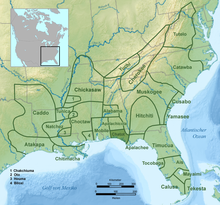 Tribal territory of Chacato during the 16th century highlighted | |
| Total population | |
|---|---|
| Extinct as a tribe | |
| Regions with significant populations | |
| United States (Florida) | |
| Languages | |
| Muskogean | |
| Religion | |
| Native, Christianity | |
| Related ethnic groups | |
| Apalachee, Amacano, Chine, Pensacola, and other Muskogean peoples |
The Chacatos were a Native American people who lived in the upper Apalachicola River and Chipola River basins in what is now Florida in the 17th century. The Spanish established two missions in Chacato villages in 1674. As a result of attempts by the missionaries to impose full observance of Christian rites and morals on the newly converted Chacatos, many of them rebelled, trying to murder one of the missionaries. Many of the rebels fled to Tawasa, while others joined the Chiscas, who had become openly hostile to the Spanish. Other Chacatos moved to missions in or closer to Apalachee Province, abandoning their villages west of the Apalachicola River.
In the late 17th century, one village of Chacatos moved from the center of Apalachee Province to near where the Chattahoochee and Flint rivers join to form the Apalachicola River, close to a Sabacola village and mission. That village was abandoned after it was attacked by Apalachicolas and others. Other Chacatos lived in small settlements scattered across the Florida panhandle, and in Tawasa and Tiquepache villages in Alabama.
After the destruction of the Apalachee Province missions by the English of the Province of Carolina and their Native American allies in 1704, the surviving Chacatos moved west with Apalachees and other peoples of the province, settling in the vicinity of Pensacola and Mobile bays. Some of those Chacatos may have been absorbed into the Choctaw nation. When West Florida was transferred to Great Britain in 1763, other Chacatos moved west to Louisiana.